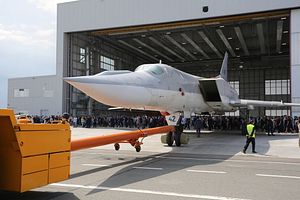The maiden flight of Russia’s upgraded Tupolev Tu-22M3M long-range strategic and maritime strike bomber has been postponed to the end of October or early November, according to a Russian defense industry source.
“There is a delay in the first flight of Tu-22M3M, the aircraft is not ready for it yet. In the best-case scenario, the aircraft will first fly at the end of October or beginning of November,” the source told TASS news agency on October 9 adding that ground trials of the aircraft are continuing meanwhile.
The first upgraded Tu-22M3M bomber — a derivative of the supersonic variable-sweep wing bomber first introduced into service with the Soviet Air Force and Soviet Naval Aviation in the 1970s — was expected to be delivered to the Russian Air Force this month. The first Tu-22M3M prototype was rolled out at a United Aircraft Corporation (UAC) plant in Kazan this August.
In comparison to its immediate predecessor the Tu-22M3, the modernized Tu-22M3M will feature upgraded avionics, new digital radio-navigation equipment, and a new communications suite, next to a number of other improvements. Notably, unlike the upgraded Tu-160M2 long-range strategic bomber, the Tu-22M3M will not be fitted with a new engine.
The bomber will also feature a modernized weapon control system, which will equip it with the capability to launch precision-guided air-launched ballistic missiles and long-range anti-ship missiles. The Tu-22M3M will be capable of firing Kh-32 long-range cruise missiles, as I explained in May:
The Kh-32, an upgraded version of the Raguda Kh-22 long-range anti-ship missile, has been specifically designed to attack U.S. Navy carrier strike groups, but can also be used for land strike missions. It is reportedly designed to climb to the stratosphere (40 kilometers) after launch and then either directly dives at the target or executes a lighter dive and approaches the target flying close to the ground at around 150-200 meters. The K-32 purportedly has an operational range of 1,000 kilometers and can reach top speeds of over Mach 4 in its terminal phase.
The Tu-22M3M can also carry the Rhaduga Kh-15 aero-ballistic missile. The bomber will be capable of carrying up to three Kh-32 or 12 Kh-15 missiles. Both the Kh-15 and Kh-32 can alternatively be fitted with conventional or nuclear warheads.
Overall, the bomber can carry a weapons load of around 24 tons.
The Russian Ministry of Defense intends to upgrade up to 30 Tu-22s to the more advanced Tu-22M3M variant. The Russian Air Force currently operates around 60 Tu-22M3s, although it is unclear how many of the bombers are flightworthy. Ten Tu-22M3s carried out airstrikes during the Vostok 2018 military exercise last month.
































